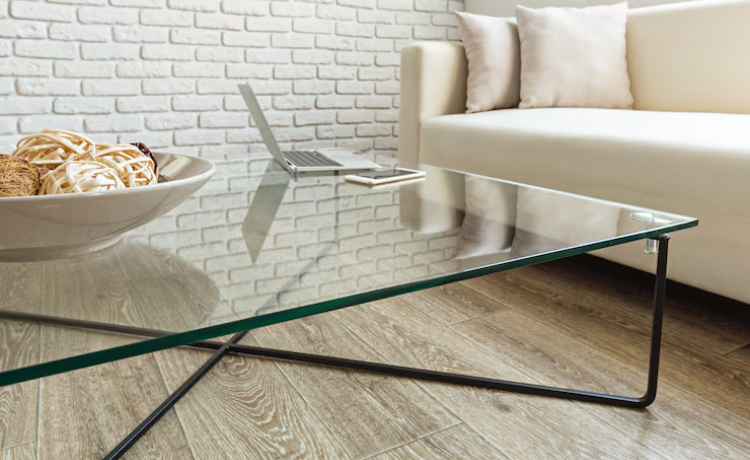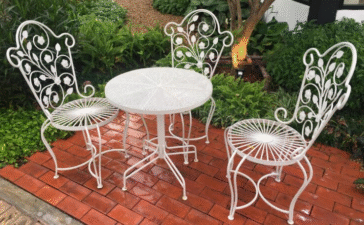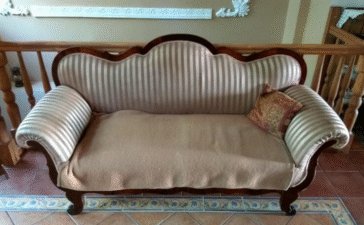A glass table top can instantly transform a room, adding a sense of elegance and space. Its transparent nature allows it to blend seamlessly with any decor, from minimalist to classic. Whether you’re looking to protect a cherished wooden heirloom, create a sleek office desk, or design a modern glass dining table, glass table tops offer unmatched versatility. They reflect light, making spaces feel brighter and more open, and their clean lines appeal to a modern aesthetic.
This guide will walk you through everything you need to know about selecting, installing, and maintaining the perfect glass table top for your home. We’ll explore different types of glass, help you choose the right size and thickness, and provide practical tips for care and repair. By the end, you’ll have the confidence and knowledge to choose a piece that enhances both the function and style of your space.
Types of Glass Table Tops
Understanding the different types of glass available is the first step in making an informed decision. The material you choose will impact the table’s safety, durability, and overall appearance.
Tempered Glass Table Tops
Tempered glass is a type of safety glass that has been treated with thermal or chemical processes to increase its strength. It is about four times stronger than regular (annealed) glass. The primary benefit of a tempered glass table top is its safety feature; if it does break, it shatters into small, dull-edged pieces rather than large, dangerous shards. This makes it an excellent choice for households with children or pets, or for high-traffic areas. A durable glass table top made from tempered glass provides peace of mind without sacrificing style.
Clear vs. Frosted Glass Table Tops
The choice between a clear and a frosted glass table top often comes down to aesthetic preference and practical needs. A clear glass table top offers a classic, unobtrusive look that showcases the table’s base and makes the room feel larger. It’s perfect for highlighting an ornate table base or maintaining an open feel.
On the other hand, a frosted glass table top provides a more decorative and opaque surface. This is beneficial for hiding smudges and fingerprints, offering a lower-maintenance option. The soft, diffused appearance of a decorative glass table top can add a touch of modern sophistication and privacy, making it a great choice for desks or dining tables where you prefer a less transparent surface.
Custom Glass Table Tops
Sometimes, a standard size or shape just won’t do. For unique furniture pieces, antique tables, or specific design visions, a custom glass table top is the ideal solution. You can specify the exact dimensions, shape, thickness, and edge finish to create a bespoke glass table top that fits your furniture perfectly. Requesting a custom size glass table top is straightforward with most suppliers; you’ll typically need to provide precise measurements and select your desired specifications online or in-store.
How to Choose the Right Glass Table Top for Your Home
Selecting the perfect glass table top involves more than just picking a style. You need to consider the size, shape, and thickness to ensure it fits your space and meets your functional requirements.
Glass Table Top Size and Shape
To measure for the perfect glass table top size, start by measuring the length and width of your table base. If you want an overhang, add a few inches to each side. For a round glass table top, measure the diameter of the base and decide on the desired overhang.
The shape of your glass table top should complement the room and the table base. A rectangular glass table top is a classic choice for dining rooms, while a round or square top can work well for smaller spaces or as a coffee table. Consider the flow of traffic around the table and how the shape will interact with other furniture in the room.
Glass Thickness: What’s Best for Your Table?
The right glass table top thickness depends on the table’s function and base support. A thicker glass table top generally offers more strength and a more substantial, premium appearance. For protective coverings on a solid table, a 1/4″ thickness is usually sufficient. Coffee tables or side tables where the glass is the sole surface, a 3/8″ thickness is a good choice. For large dining tables or desks that need to support significant weight, a 1/2″ thick glass table top provides the necessary durability. Our glass thickness guide can help you make the best decision based on your specific needs.
Installation and Maintenance Tips
Proper installation and care are essential for ensuring your glass table top remains secure and beautiful for years to come.
How to Install a Glass Table Top
To install a glass table top on a wooden or metal base, you will need to secure it properly to prevent it from shifting. The simplest method is to use clear plastic bumpers or felt pads. These small discs create friction and a slight cushion between the glass and the base. Place them evenly around the perimeter of the table base. For a more permanent solution, especially on a solid wood base, you can use specialized glass table top fasteners. This is how you secure a glass table top to ensure it is stable and safe for everyday use.
Caring for Your Glass Table Top
To clean a glass table top without leaving streaks, use a mixture of water and white vinegar or a commercial glass cleaner. Spray it lightly on the surface and wipe it with a microfiber cloth. Avoid abrasive cleaners or scouring pads that could scratch the glass. For general glass table top maintenance, use coasters and placemats to protect the surface from scratches and heat. Regular dusting and cleaning will keep it looking pristine.
Repairing a Chipped or Cracked Glass Table Top
If you notice a small chip, a DIY repair kit for a chipped glass table top can sometimes be effective. These kits typically use a clear resin to fill the chip and prevent it from spreading. However, for larger cracks or significant damage, it’s best to consult a professional. If the crack compromises the structural integrity of the table, replacement is the safest option. Our glass table top repair guide can offer more detailed steps for minor fixes.
Glass Table Tops: Pros and Cons
Weighing the advantages and disadvantages can help you decide if a glass table top is right for you.
Advantages of Glass Table Tops
The benefits of a glass table top are numerous. Its aesthetic appeal is undeniable, creating a light and airy atmosphere. Glass is also non-porous, making it resistant to stains and easy to clean. The versatility in design means you can find a glass table top to suit any interior style, which is why they remain a popular choice for modern homes.
Potential Downsides to Consider
Despite their beauty, there are some cons of a glass table top. Glass can be fragile and prone to chipping or cracking if hit with a heavy object. The surface can also show fingerprints and smudges easily, requiring frequent cleaning. You can minimize these disadvantages of a glass table top by choosing tempered glass for durability and using coasters and placemats to protect the surface.
Where to Buy Glass Table Tops
Knowing where to find a quality product is crucial. You can choose to buy glass table tops online or from a physical store, each with its own set of pros and cons.
Buying Online vs. In-Store
Shopping for a glass table top purchase online offers convenience and a wide selection. You can easily compare prices and read reviews. However, you won’t be able to see the product in person before buying. In-store shopping allows you to inspect the quality and get expert advice, but your options might be more limited. When you buy a glass table top online, look for reputable sellers with clear return policies and good customer reviews.
Choosing the Right Supplier
When selecting a glass table top supplier, consider factors like their range of customization options, product quality, and customer service. Look for a custom glass table top supplier if you have unique requirements. Reading reviews and comparing quotes from reliable glass table top vendors will help you find the best value and quality.
You would also like: “farmyard table“
A Timeless Addition to Your Home
Glass table tops are a stylish and functional choice for any home. They offer a unique blend of elegance, versatility, and practicality that can elevate your interior design. By understanding the different types, choosing the right specifications, and performing regular maintenance, you can enjoy the beauty of a glass table for many years. We encourage you to explore the options and select the perfect piece that aligns with your personal style and functional needs.
Frequently Asked Questions (FAQs)
What is the most durable glass for a table top?
The most durable glass for table tops is tempered glass. It is heat-treated to be about four times stronger than standard annealed glass. If it breaks, it shatters into small, pebble-like pieces, which significantly reduces the risk of serious injury. This makes it the safest and most durable option, especially for dining tables, coffee tables, and desks in busy households.
How do I properly measure for a glass table top?
To measure for a glass table top, first decide if you want the glass to be flush with the base or have an overhang. For a square or rectangular table, measure the length and width of the base. An overhang, add your desired measurement (typically 1-2 inches) to each side. For a round table, measure the diameter of the base and add twice the desired overhang measurement to determine the final diameter of the glass. Always double-check your measurements before ordering.
Can I use a glass table top for outdoor furniture?
Yes, you can use a glass table top for outdoor furniture, but it’s crucial to choose the right type of glass. Tempered glass is the best choice for outdoor use because of its strength and safety features. It can withstand temperature fluctuations better than standard glass. Ensure the edges are properly finished to prevent chipping and that the base is sturdy enough to support the glass in various weather conditions.
How can I repair a small chip or crack in my glass table top?
For small, minor chips or cracks, you can use a DIY glass repair kit, which you can find at most hardware stores. These kits typically contain a clear epoxy or resin that fills the damaged area, making it less noticeable and preventing it from spreading. Follow the kit’s instructions carefully. For larger cracks or more significant damage, it’s best to consult a professional glass repair service or consider replacing the top to ensure safety.
How do I prevent scratches on my glass table top?
To prevent scratches, always use coasters under glasses and mugs, and placemats under plates and dishes. Avoid sliding rough or heavy objects across the surface. When cleaning, use a soft microfiber cloth and a non-abrasive cleaner. Placing decorative felt pads under any items that will sit permanently on the table, like a vase or lamp, can also help protect the glass.












